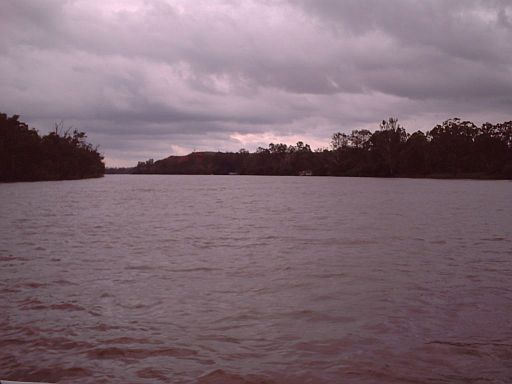
Sunrise on the Murray River
|
After the frantic activities of the previous two weeks, one might think that hanging around on a house boat could be kind of a let down. Well, it was, a bit. After all, we'd been quite busy on our holiday so far, and after one goes the first few miles, the river begins to look the same after a while. We arrived in Renmark after a drive of a few hours, including a cable pulled ferry ride in some dinky little stop that wasn't much more than a convenience store and a drive / park way to wait for the ferry. Renmark was actually a town of some size, although not up to “city” standards. It was bigger than a crossroads, and that's all that counted. There was a bit of confusion as Liz, C, and I all went grocery shopping. We duplicated some items and forgot others in proportion to our hurry. We did manage to get beer and wine, so the trip wouldn't be a complete waste. We did forget toilet paper and fishing tackle, so Stuart had to go back to town from the boat launch area. Roger, the quietest man in Australia, showed us about on the boat, explaining the systems (more to Stuart than to me, as I hardly heard a word he said). We took the boat and Roger on a test spin, then dropped him off at the riverside tavern, and off we went. The River Murray is the South Australian big muddy, similar to our Mississippi River, and it supplies drinking and irrigation water for a lot of country, perhaps two million people. I feel more comfortable washing my hands after urinating, and it wasn't until the second day that I figured out that I was washing my hands with river water. I hardly expect that the river water is cleaner than my penis, but I felt better having done so. I thought that the brown water coming out of the tap was just rusty pipes, but it was the real deal, pumped from the river into the sinks. We had drinking water in tubs, but it isn't best used for hand washing. I used the sink water the first time that I made coffee, and I wasn't surprised that the drink was dark. I should have been though. We didn't get far that first day, and we found a beach to pull up against for the night. It turns out that Australians are a people of big shoulders, because another boat pulled up to a nearby beach, and no amount of Elvis on the ukulele could chase them away. Our hosts bristled a bit, but we dealt with it anyway. | |||||||
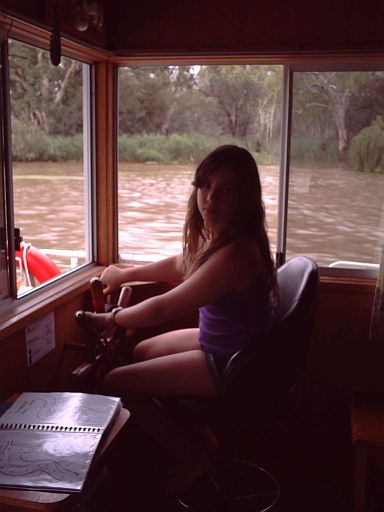
Captain Carys orders Battle Stations!
| A big surprise: I still have apnea. With no power to the boat I didn't sleep at all that first night. It was a long night, albeit quite dark. I worked hard not to be grumpy the next day, but I don't remember the last time that I slept without the machine. We made some time the next day, casting off and powering up the river early in the morning. Australia's is an old geology, and the river has done a lot of meandering over the last few million years. I drove the boat during some of the more twisty bits, and the current is kind of strong, as it's been raining quite a bit, both before we arrived and a bit afterwards. We not only brought our Seattle rain with us, but our Queensland rain as well. (As you’ll recall, our escape from Queensland proved that we could swim with all of our belongings with us) We stopped at one place on the river in a spot that had been used to inter Australian citizens of Japanese descent, where they were put to work cutting trees that were used to power something or other during WWII. Apparently America wasn't the only country to lock up their own citizens based on their ethnicity, although Australia had more excuse than we did. After all, it seemed like Japan was poised to invade Australia from the north, something that North America never experienced. There was an old shack left from the day, and C noticed that there was a wasp nest right above my head. She was afraid that I was going to poke it with a stick or something, but she needn't have worried. I'm sure that the local wasps are quite nasty in their way, and I had no interest in finding out just how nasty they could be. I also passed a really big spider hanging across the trail, big enough that I went back to the boat to get the camera. It wasn't as big as the one that I saw at the Adelaide zoo, but it was close enough to the trail to get my hand behind for perspective. Plenty big. C had wandered off into the bush, and I followed her, alerting her to the fact that she had wandered past several rope like spider webs. She followed me quite closely in my footsteps on our return trip to the boat, taking no chances.
| 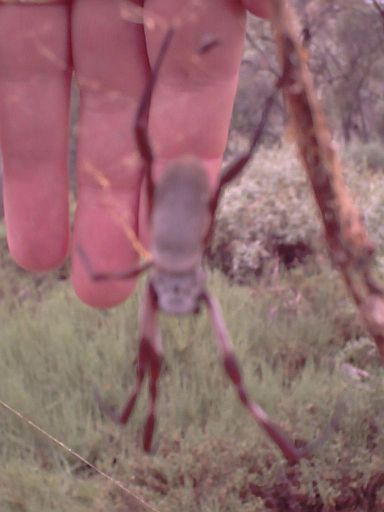
A Spider? Or a mouse with eight legs? 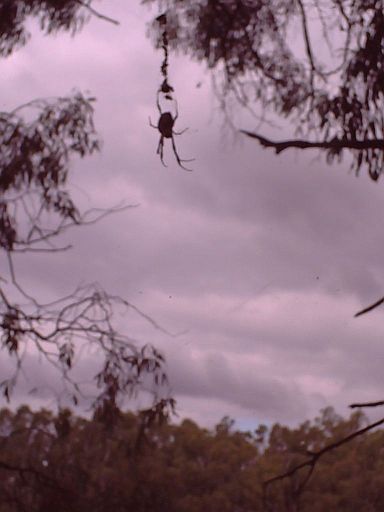
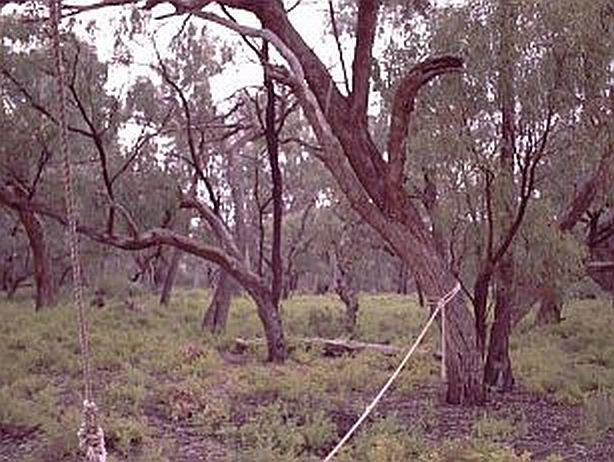
If you think the spiders are big, you should see their webs! 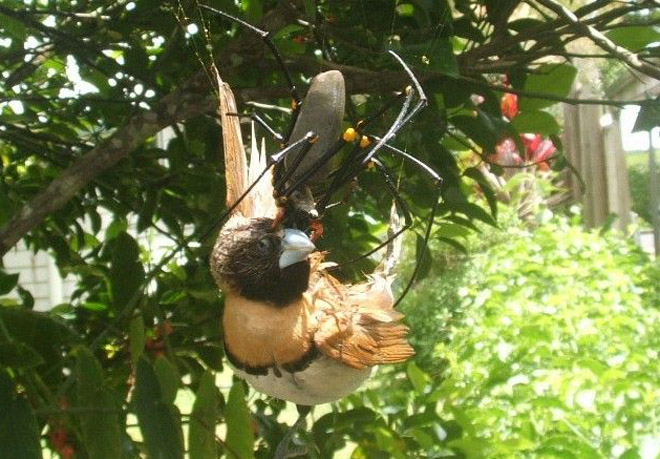 Aw hell no!
| We found a nice beach to pull up to for the night, and it wound up being a glorious thing. It turns out that in Australia, it's the women who are the pyros, and Liz and Carys were the ones that gathered brush for a fire. It was a marvelous thing sitting about a fire with friends in the solitude. The three ladies experimented with the roasting of marshmallows, with mixed success. Then the sky cleared. Before the moon rose up the sky was a wondrous splash of stars and a streak of the Milky Way, there in the sky in combinations that I had never seen before. I did recognize the constellation Orion, but other than that the sky was all new. And I have now seen the Southern Cross. I should mention the yabbies. We’d call them crawdads or crawfish, shrimp like crustaceans that have crab like pincers and tails that flick them away from trouble. One of the items on my bucket list was to fish for, cook, and eat them, having seen them described in a link sent to me by the Jones’ before our departure. There’s a limit of 200 a day which we never even came close to capturing, netting a few dozen in our two days of fishing. The trap was a net floor and roof, with the roof being supported by two arcs of wire. The way the trap looked was reminiscent of the Sydney Opera house, and in fact was called an opera house trap. I wondered what this type trap was called before 1957? In any case, we caught them and boiled them and stripped the shells from the meat as best we could. They were kind of tasty, especially with some garlic salad dressing and wrapped in pita bread. The most interesting yabby story was when Stuart was going to take one out of the trap and put it back in the water, thinking that it was too small to keep and eat. Apparently this particular yabby had no idea that it was meant to be released. Instead, it latched onto the skin on Stuart’s hand between thumb and finger, and great pain ensued. Stuart flicked his hand in an effort to disengage the yabby, but this only succeeded in tearing off the yabby claw, which remained attached to Stuart’s hand. The rest of the body flew into the air and bounced off of Carys’ head. If it had stuck there, we would have seen if little girls can walk on water. As it was, we threw what remained of “Lefty” into the river as originally planned, but we boiled up his claw for food that night. Jokes about “Lefty” continued throughout the holiday. We also spent a bit of time and tackle trying to catch the elusive Golden Perch. Not a ticket to the factory of Willy Wonka, but a fish that was expected to be good eating. What we caught instead was a series of trees and brush that were underwater due to the high water level. We lost all the hooks, and in the end all we caught was a European Carp, an introduced species so invasive that the fishing rule book instructed us not to put it back in the water. We left it on an ant hill to die a horrible death.
| 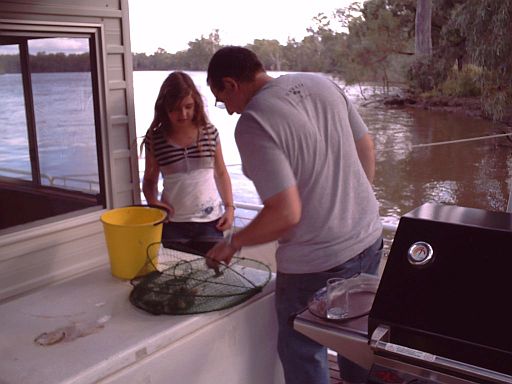
The Great Yabby adventure, before the amputation.
| The next day promised to be pretty dull, as the scenery wasn’t expected to change. The excitement of the river trip was beginning to wane. A vote was formed and it was decided to power back to Renmark for more excitement than was promised with another night camping on the river. Now don’t get me wrong: the river was a glorious thing. It’s just that I was looking for a bit more excitement in my holiday. So the next day we rowed back to the big city. What took us the better part of a day and a half upstream took most of the morning downstream. It’s amazing how currents work like that. I’d gotten up and showered (in river water), but I took over the controls for the last half of the trip. It might be just because the river level was so high that I managed to miss the sand bars, but luck was on my side. As we started to pull into the docking beach, I was told that I could go between those two trees in the river. It turns out that they were kidding, and when I started to make the turn to do so, I was corrected quickly enough that I didn’t beach the boat.
| 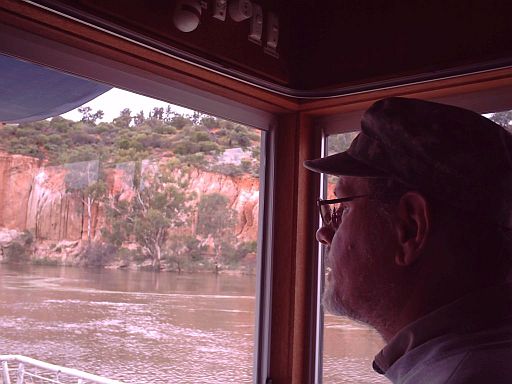
The Captain wants to go water skiing!
| Stuart and Carys stayed behind while Liz, C, and I made for the big city. Or I should say “cities”. We also went to Paringa and Berri. Did I mention Op shops already? We found two of them in the three “cities” that we visited, as well as numerous antique shops. We’d already gotten the Jones’ a ukulele, but one of the latter shops had a drum kit. I thought about getting that for Carys, but I decided that I liked them all more than that. Paringa also had an unusual tourist thing. What we read on the map was “the eleventh largest black stump in Australia”. That would have been funny, but what it really was was the largest of eleven such stumps in Australia. Or something like that. A Wikipedia search for Black Stump tells that it’s a phrase meaning something like “the end of the earth”, as in “turn left and keep on going until you see the black stump”. In any case, the Black Stump of Paringa is actually a beautiful thing. It’s a stump of a tree that was found sticking out of the river bank after a flood, and some enterprising individual decided that he wanted it. After it was freed from the bank, they tied a couple of empty oil drums underneath it as well as an outboard engine, and off they went, so many miles, er, kilometers, to Paranga. The engine ran out of gas three times, and they were almost run over by a transport ship, but they finally got it to town. A special chain saw was brought in and used to cut slices from the trunk, taking three hours to do so, the pieces going to special projects the character that got the stump had in mind. (I don’t know if everybody in Australia is a character, but it seems to help.) What remains of the stump was turned on its side, and in its own beautiful way serves as the (only) tourist destination in Paringa. Just outside of Renmark we went to Australia’s largest rose garden and motor museum. I’m not sure if the “largest” is for the pair, but there was a large garden and a small museum. I guess it was a place for both him and her. We sat for tea and cake, and sat and enjoyed the floor not moving for a while. We also went to the local cemetery. A note about cemeteries in Australia. Because so much of Australian culture is based on the English model, it’s possible that their cemetery traditions are as well. Lots of “Peacefully at Rest”, and other quaint phrases about who was left behind were carved into headstones. Not just “loving husband of” but “brother of” as well, reeling off relations to the whole family. Sometimes the cause of death is on the stone as well. My favorite was “drowned while retrieving his hat from the river”. One stone (in the Burra cemetery, visited later) was in Gaelic, with no English at all. In America, the cemeteries are park like, with lots of grass and trees. The two cemeteries that we visited on this leg were pink hard gravel around the graves, and often some colored stones inside the short fences surrounding the actual plots. Oftentimes, whichever spouse that died first was dug up and the other spouse was buried in the same plot when their end came. For such a large country, it seemed like they were trying to save space. And then one has to mention the dereliction. Many of the graves were in sad condition, with the ground having subsided to a significant degree over the passing years. Most horrific was where a hole had formed over the grave, where whatever box (or blanket or whatever) that once held up the ground had given way. I teased C about how the restless dead were trying to get out. Also horrific was the colonies of big black ants that I saw at the Burra cemetery that were swarming out of their nest built into and on top of the graves. Apparently they had discovered a taste for human flesh, and a monster movie is sure to come. The stones were often broken from having tilted and fallen, and some of the graves had caution tape up around them to warn of falling head stones. Erie… We returned to the boat, and after gathering up the clans we went to the Renmark Hotel for dinner. I had kangaroo steak, crossing off one of the items from my bucket list. It was tender enough, but kind of strange tasting. Not unlike beef, but the phrase used by others was “gamey”. It certainly tasted better with the sweet potato / yam that came with the meal. After dinner we went to the park across the street and watched the “possums” come down from their lairs in the palm trees along the river. These were not the “opossums” that we’re used to in the States, but some other kind of marsupial creature, having a body like a squirrel and the face of a monkey, maybe a rhesus type, or maybe a big rodent. They’re kind of hard to describe, but that’s true of most of Australia’s wildlife, as they’re so different as to defy description. They were cute, and surprisingly soft, much like the koalas we’d petted earlier. They had long tails with a little pinky finger type end to it to help them hold on to trees. They were coaxed down nightly by the flower petals that people put beneath the trees. They spent the day under the folded foliage of the palm trees, coming out at night to feed, and to be petted by the tourists. We went back to the boat to spend the night, but not before I taught Carys to play Guillotine. The next day we left to go to Burra. Continue to The Great Australian Adventure, part 4 |
|
This page is authored and maintained by Rich Webb. You can send E-mail to me by following this link to the contact page. And feel free to contact me if you have any comments, criticisms, or suggestions. I remain, however, perfectly capable of ignoring your useless opinion... |